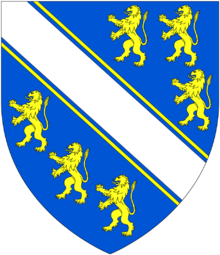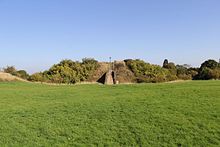- Grandson (maternal) of the Kings of Scotland
- 28-Apr-1200: Created 1st Earl of Hereford (England)
- 1215: A surety baron for the Magna Carta
- 1217: Endured capture at the Battle of Lincoln
- 1220: Died on the 5th Crusade to the Holy Land
Henry de Bohun, 1st Earl of Hereford, was born 1176 to Humphrey de Bohun (bef1144-1181) and Margaret of Huntingdon (1140-1201) and died 1 June 1220 Egypt of unspecified causes. He married Maud Fitzgeoffrey (-1236) .

Arms of Bohun, adopted at start of age of heraldry (c.1200-1215): Azure, a bend argent cotised or between six lions rampant of the last

The motte and late-medieval brick bridge of Pleshey Castle in Essex, chief residence of Henry de Bohun

Arms of Bohun drawn by Matthew Paris (d.1259)
Henry de Bohun, 1st Earl of Hereford (1176 – 1 June 1220) of Pleshey Castle in Essex, was an Anglo-Norman nobleman who became Hereditary Constable of England from 1199.
Origins
He was the son and heir of Humphrey IV de Bohun of Trowbridge Castle in Wiltshire and of Caldicot Castle in south-east Wales, 5th feudal baron of Trowbridge,[1] who served King Henry II as Lord High Constable of England. His mother was Margaret of Huntingdon, widow of Conan IV, Duke of Brittany (d.1171) and a daughter of Henry of Scotland, 3rd Earl of Northumberland, 3rd Earl of Huntingdon, son of King David I of Scotland by his wife Maud, 2nd Countess of Huntingdon. Henry's half-sister was Constance, Duchess of Brittany.
Earldom
His paternal grandmother was Margaret of Hereford, a daughter of Miles FitzWalter of Gloucester, 1st Earl of Hereford, Lord of Brecknock (died 1143), Sheriff of Gloucester and Constable of England. After the male line of Miles of Gloucester failed, in 1199 King John created Henry de Bohun Earl of Hereford and Constable of England. His lands lay chiefly on the Welsh Marches, and from this date the Bohuns took a foremost place among the Marcher barons.[2]
Henry de Bohun was one of the twenty-five barons elected by their peers to enforce the terms of Magna Carta in 1215. He was subsequently excommunicated by the Pope. In the civil war that followed Magna Carta, he was a supporter of King Louis VIII of France and was captured at the Battle of Lincoln in 1217.
Marriage and issue
He married Maud de Mandeville (alias Maud FitzGeoffrey), daughter and heiress of Geoffrey Fitz Peter, 1st Earl of Essex, of Pleshey Castle in Essex, by whom he had issue including:
- Humphrey (V) de Bohun, 2nd Earl of Hereford (1204-1275), eldest son and heir, created Earl of Essex in 1239, who married Maud de Lusignan, by whom he had at least three children.
- Henry de Bohun, who died young.
- Ralph de Bohun.
Death
He died in June 1220 while on crusade to the Holy Land. That year the crusaders were in the midst of a multi-year effort to capture Cairo, Egypt on the Nile River - their gateway to the Holy Land. [3]
Children
| Name | Birth | Death | Joined with |
| Humphrey de Bohun, 2nd Earl of Hereford (c1208-1275) | 1208 England | 24 September 1275 Warwickshire, England, United Kingdom | Maud de Lusignan (c1210-1241) Maud de Avenbury (-1273) |
| Henry de Bohun (c1210-) | |||
| Ralph de Bohun (c1212-) | |||
Siblings
| Name | Birth | Death | Joined with |
| Henry de Bohun, 1st Earl of Hereford (1176-1220) | 1176 | 1 June 1220 Egypt | Maud Fitzgeoffrey (-1236) |
See Also
- Henry Bohun
- Bohun Family
- Bohun Family Ancestry
External Links
- wikipedia:en:Henry de Bohun, 1st Earl of Hereford
- Henry de Bohun, 1st Earl of Hereford at thePeerage
- Henry de Bohun, 1st Earl of Hereford, Geni.com, https://www.geni.com/people/Henry-de-Bohun-Earl-of-Hereford-Surety-of-the-Magna-Carta/6000000001434670985, retrieved 24 Jan 2024
- Bohun Family Genealogy, TudorPlace.com.ar, http://www.tudorplace.com.ar/BOHUN.htm, retrieved 24 Jan 2024
- Henry de Bohun, 1st Earl of Hereford at Find A Grave
- de Bohun Family Genealogy, OlyPen.com Genealogy, https://olypen.com/zob/genealogy/England-tree/Bohun/Bohun.html, retrieved 24 Jan 2024
- MedLands Project, fmg.ac, http://fmg.ac/Projects/MedLands/ENGLISH%20NOBILITY%20MEDIEVAL.htm#HumphreyBohunMMargaretHuntingdon, retrieved 24 Jan 2024
Bibliography
- Pollock, M. A. (2015). Scotland, England and France After the Loss of Normandy, 1204-1296. The Boydell Press.
- Pollock, M. A. (2015). Scotland, England and France After the Loss of Normandy, 1204-1296. The Boydell Press.
- Cokayne, G. (ed. by V. Gibbs). Complete Peerage of England, Scotland, Ireland, Great Britain and the United Kingdom. London:1887-1896, H-457-459
Notable Ancestors
Notable Descendants
Peerage Tables
| Honorary titles | ||
|---|---|---|
| Preceded by Humphrey III de Bohun |
Lord High Constable 1199–1220 |
Succeeded by Humphrey (V) de Bohun |
| Peerage of England | ||
| New creation | Earl of Hereford 1199–1220 |
Succeeded by Humphrey (V) de Bohun |
References
- ^ Sanders, I.J. English Baronies: A Study of their Origin and Descent 1086-1327, Oxford, 1960, p.91
- ^
 One or more of the preceding sentences incorporates text from a publication now in the public domain: Davis. "Bohun". In Chisholm, Hugh. Encyclopædia Britannica. 4. Cambridge University Press. p. 137.
One or more of the preceding sentences incorporates text from a publication now in the public domain: Davis. "Bohun". In Chisholm, Hugh. Encyclopædia Britannica. 4. Cambridge University Press. p. 137.
- ^ BOMC: Profiles of Magna Charta Sureties and Other Supporters
Footnotes (including sources)
| ¶ Death |
|